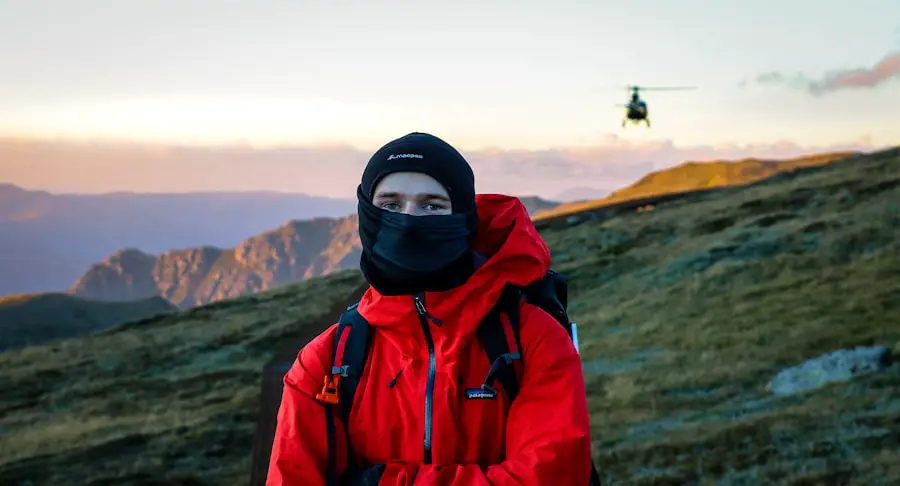Layering is a fundamental principle in outdoor clothing that significantly enhances comfort and performance during various activities, particularly in hiking and other outdoor adventures. The concept revolves around wearing multiple layers of clothing, each serving a specific purpose, which allows for better temperature regulation, moisture management, and protection against the elements. By employing a layering system, outdoor enthusiasts can adapt to changing weather conditions and their own body temperature fluctuations, ensuring they remain comfortable throughout their journey.
The layering system typically consists of three main components: the base layer, mid layer, and outer layer. Each layer plays a crucial role in maintaining body heat, wicking away moisture, and providing protection from wind, rain, or snow. Understanding how to effectively utilize these layers can make a significant difference in the overall experience of being outdoors.
For instance, if one layer becomes wet from sweat or rain, the other layers can still function effectively to keep the body warm and dry. This adaptability is essential for anyone who spends extended periods in nature, where conditions can change rapidly.
Key Takeaways
- Layering is important for regulating body temperature and staying comfortable during outdoor activities.
- Choose a base layer made of moisture-wicking material like merino wool or synthetic fabrics to keep sweat away from the skin.
- The mid layer provides insulation and warmth, and can be made of fleece, down, or synthetic materials.
- The outer layer should be waterproof and windproof to protect from rain, snow, and wind.
- Don’t forget to pack hats, gloves, and scarves to protect your extremities from the cold.
Base Layer: Choosing the Right Material
Material Options for Base Layers
Common materials for base layers include synthetic fabrics like polyester and nylon, as well as natural fibers such as merino wool. Each material has its own set of advantages and disadvantages, making it essential to choose wisely based on the specific conditions and personal preferences.
Synthetic Base Layers: Quick-Drying and Durable
Synthetic base layers are often favored for their quick-drying properties and durability. They excel in wicking moisture away from the skin, which helps to regulate body temperature during high-intensity activities. For example, a polyester blend base layer can effectively pull sweat away from the body during a strenuous hike, keeping the wearer dry and comfortable.
Natural Insulation with Merino Wool
On the other hand, merino wool is renowned for its natural insulating properties and odor resistance. It can provide warmth even when wet, making it an excellent choice for colder climates or damp conditions. Additionally, merino wool is soft against the skin, reducing the risk of chafing during long hikes.
Mid Layer: Insulation and Warmth

The word “Synthetic insulation” in the text can be linked to a relevant source such as REI (Recreational Equipment, Inc.), which is a high authority source for outdoor gear and clothing. Here is the link: REI Synthetic Insulation
Outer Layer: Protection from the Elements
| Product | Waterproof Rating (mm) | Breathability Rating (g/m2/24h) | Windproof |
|---|---|---|---|
| Jacket A | 10,000 | 10,000 | Yes |
| Jacket B | 20,000 | 15,000 | Yes |
| Jacket C | 30,000 | 20,000 | Yes |
The outer layer is your shield against wind, rain, snow, and other environmental challenges that can arise during outdoor activities. This layer is designed to be both waterproof and breathable, ensuring that while it protects against external moisture, it also allows sweat vapor to escape from within. The effectiveness of an outer layer is often determined by its material and construction features.
Gore-Tex is one of the most recognized materials used in high-performance outer layers due to its exceptional waterproofing capabilities combined with breathability. Jackets made from Gore-Tex are ideal for hiking in rainy or snowy conditions as they keep water out while allowing perspiration to escape. However, not all waterproof materials are created equal; some may offer varying levels of breathability or durability.
Therefore, it’s essential to consider factors such as seam sealing and fabric weight when selecting an outer layer. In addition to waterproofing, wind resistance is another critical feature of an effective outer layer. Windproof jackets are designed to block cold winds that can quickly sap body heat during outdoor activities.
Many modern outer layers combine both waterproofing and windproofing features into a single garment, providing comprehensive protection against harsh weather conditions. When choosing an outer layer, it’s also important to consider additional features such as adjustable hoods, cuffs, and ventilation zippers that enhance comfort and functionality on the trail.
Accessories: Hats, Gloves, and Scarves
Accessories play a vital role in completing the layering system and ensuring overall comfort during outdoor activities. Hats, gloves, and scarves are essential items that help protect extremities from cold temperatures and wind chill while also providing additional insulation when needed. The right accessories can make a significant difference in maintaining warmth and comfort throughout a hike.
A well-fitted hat is crucial for retaining body heat since a significant amount of heat escapes through the head. Beanies made from wool or synthetic materials are popular choices as they provide warmth without being overly bulky. Additionally, hats with brims can offer protection from sun exposure or rain, making them versatile for various weather conditions.
For colder climates, consider hats that cover the ears or have built-in face masks for added protection against biting winds. Gloves are another essential accessory that should not be overlooked. Insulated gloves or mittens can keep hands warm during chilly hikes; however, it’s important to balance warmth with dexterity.
Some gloves come with removable liners that allow for versatility depending on temperature changes throughout the day. Scarves or neck gaiters can also provide extra warmth around the neck area while offering protection against wind exposure. These accessories not only enhance comfort but also contribute to overall safety by preventing frostbite or hypothermia in extreme conditions.
Footwear: Choosing the Right Hiking Boots

Footwear is arguably one of the most critical components of any outdoor adventure gear list. The right hiking boots can make or break an experience on the trail by providing support, traction, and protection from various terrains. When selecting hiking boots, several factors must be considered including fit, material, ankle support, and tread pattern.
A proper fit is paramount; boots should feel snug but not overly tight to allow for foot swelling during long hikes. It’s advisable to try on boots with the socks you plan to wear on your hike to ensure an accurate fit. Additionally, different types of hiking boots cater to various terrains—lightweight trail runners may be suitable for well-maintained paths while heavier backpacking boots offer more support for rugged trails with heavy loads.
Material also plays a significant role in determining the performance of hiking boots. Leather boots are known for their durability and water resistance but may require a break-in period before they become comfortable. Synthetic materials like nylon or mesh offer lighter weight options with increased breathability but may not provide the same level of durability as leather counterparts.
Furthermore, tread patterns on the soles of hiking boots are designed to provide traction on different surfaces; deeper lugs are ideal for muddy or rocky terrain while flatter soles may suffice for well-groomed trails.
Packing Essentials: What to Bring in Your Backpack
When preparing for a hike, packing essentials in your backpack is crucial for ensuring safety and comfort throughout your journey. A well-thought-out packing strategy can help you avoid unnecessary weight while ensuring you have everything you need for various situations that may arise on the trail. First and foremost, hydration should be prioritized; carrying enough water is essential for maintaining energy levels during physical exertion.
Hydration packs or water bottles should be easily accessible within your backpack to encourage regular drinking throughout your hike. In addition to water, consider packing electrolyte tablets or sports drinks to replenish lost minerals during strenuous activities. Other essentials include food items that provide sustained energy such as trail mix, energy bars, or jerky.
These snacks should be lightweight yet nutrient-dense to keep you fueled without adding excessive weight to your pack. Additionally, a first aid kit is vital for addressing minor injuries or ailments that may occur on the trail; it should include items like adhesive bandages, antiseptic wipes, pain relievers, and blister treatment supplies. Navigation tools such as maps or GPS devices are also important components of your packing list; they help ensure you stay on course during your hike.
A multi-tool or knife can serve various purposes from food preparation to gear repairs while extra layers of clothing should be included based on weather forecasts to prepare for sudden changes in temperature.
Tips for Staying Comfortable and Safe on the Trail
Staying comfortable and safe while hiking requires careful planning and awareness of your surroundings throughout your journey. One key tip is to monitor your body’s signals; if you start feeling too hot or cold, take a moment to adjust your layers accordingly rather than waiting until discomfort escalates into a more serious issue. Pacing yourself is another important aspect of enjoying a hike; maintaining a steady pace helps conserve energy over long distances while allowing you to take in your surroundings without feeling rushed.
Regular breaks should be incorporated into your hiking schedule—this not only provides an opportunity to hydrate and refuel but also allows time for rest and recovery. Additionally, being aware of trail conditions can significantly impact safety; checking weather forecasts before heading out can help you prepare adequately for potential challenges such as rain or snow accumulation on trails. Familiarizing yourself with local wildlife precautions is also essential—understanding how to respond if encountering animals like bears or snakes can prevent dangerous situations.
Lastly, hiking with a buddy or group enhances safety by providing support in case of emergencies while also making the experience more enjoyable through shared camaraderie on the trail. By following these tips and being prepared with appropriate gear and knowledge about layering systems, hikers can maximize their comfort and safety during outdoor adventures.
If you’re planning a hiking trip in 40-degree weather, you’ll want to make sure you’re dressed appropriately to stay warm and comfortable. Check out this article on the best carry-on luggage for international travel for tips on packing efficiently for your trip. Having the right gear and clothing can make all the difference in enjoying your outdoor adventure.
FAQs
What should I wear when hiking in 40-degree weather?
When hiking in 40-degree weather, it’s important to dress in layers. Start with a moisture-wicking base layer, add an insulating layer, and finish with a waterproof and windproof outer layer. Don’t forget to wear a hat, gloves, and warm socks.
What are the best materials for hiking in 40-degree weather?
For hiking in 40-degree weather, it’s best to choose clothing made from moisture-wicking and insulating materials such as merino wool, polyester, or fleece. These materials will help keep you dry and warm during your hike.
Should I wear waterproof clothing when hiking in 40-degree weather?
Yes, it’s important to wear waterproof and windproof outer layers when hiking in 40-degree weather. This will help protect you from rain, snow, and wind, keeping you dry and warm throughout your hike.
What type of footwear is best for hiking in 40-degree weather?
When hiking in 40-degree weather, it’s best to wear waterproof and insulated hiking boots to keep your feet warm and dry. Make sure your boots have good traction to prevent slipping on wet or icy trails.
Do I need to wear sunscreen when hiking in 40-degree weather?
Yes, it’s important to wear sunscreen when hiking in 40-degree weather, especially if you’ll be exposed to snow or high altitudes. The sun’s rays can still be strong, and snow can reflect and intensify UV radiation, increasing the risk of sunburn.
